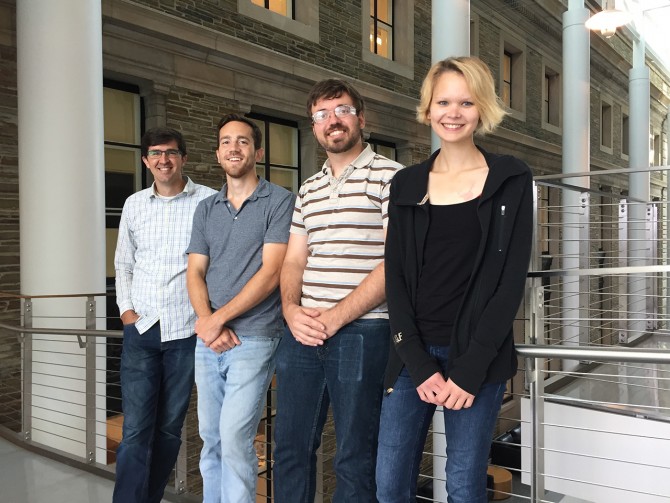On-demand polymers may yield designer materials
By Tom Fleischman
Researchers at Cornell are devising a method for creating new polymers in much the same way that a jewelry maker creates a beaded necklace – with the beads strung in a precise, controlled way.
The lab of Brett Fors, assistant professor of chemistry and chemical biology, has experimented in the past with creating “designer polymers” using two photocatalysts. The process alternates the binding of sub-units (monomers), when either blue or green light was shown on them. The team has taken that approach to the next level in a paper just published in ACS Central Science.
For this work, Fors and colleagues used blue light to bind one type of monomer, and a chemical stimulus to connect the other. By toggling between the light or the chemical additive, and controlling how long the stimulus was applied, they could selectively choose which subunit was added to the growing polymer molecule – like beads on a necklace.
“The idea is, if you can precisely control polymer structure, then you should be able to control function,” Fors said. “That’s really what we want to do – to be able to use external stimuli to have precise control over the monomer connectivity in the polymer backbone.”
Doctoral students Brian Peterson, Veronika Kottisch and Michael Supej, all from the Fors Lab, co-authored “On Demand Switching of Polymerization Mechanism and Monomer Selectivity With Orthogonal Stimuli,” published Aug. 8. ACS Central Science is an open-access journal of the American Chemical Society.
The group’s previous polymerization work had a key limitation: the ability to switch the polymerization process from one monomer to the other and back again, due to the two catalysts’ similar light-absorption properties, which made it impossible to completely shut off one reaction while the other was occurring.
The answer was a polymerization process that featured two different but compatible stimuli – in this case, light and a chemical oxidant.
“The challenge was finding stimuli that won’t interfere with one another,” Supej said, “such that you promote the formation of one block while not polymerizing the other.”
The process was initiated by an oxidizing ferrocenium salt, which promoted the polymerization of the first monomer. Important was the ability to completely shut off that monomer’s polymerization while simultaneously stimulating the second, which the group was able to achieve via chemical reactions.
The resulting polymer exhibited high molecular weight and low dispersity, both desired properties in polymers.
Fors said this extension of the group’s previous polymerization work represents a major step forward. “We showed in the past that we could switch polymerization mechanisms by just changing our external stimulus [light color],” he said. “But it didn’t allow us to switch back and forth between monomers. This does.”
The monomers Fors and his group used in their di-block polymer, isobutyl vinyl ether and methyl acrylate, were chosen due to their reactivity and the group’s familiarity with those materials. In the future work, Fors’ group plans to employ new monomers and different types of stimuli, to create as-yet-undiscovered polymers.
“It’s almost impossible to find things that don’t involve polymers in everything you do on a daily basis,” he said. “So if we can even better control the polymer structure, we’re hoping that this is going to lead to some really big advances. It’s really kind of an enabling technology.”
This work was supported by grants from the National Science Foundation and by Fors’ Sloan Research Fellowship, provided by the Alfred P. Sloan Foundation.
Media Contact
Get Cornell news delivered right to your inbox.
Subscribe

